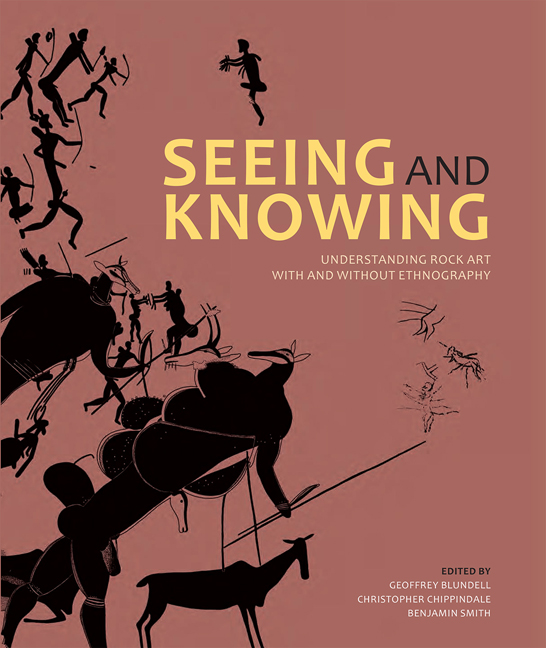Book contents
- Frontmatter
- Dedication
- Contents
- Contributors
- Acronyms
- Chapter 1 Rock art with and without ethnography
- Chapter 2 Flashes of brilliance: San rock paintings of heaven's things
- Chapter 3 Snake and veil: The rock engravings of Driekopseiland, Northern Cape South Africa
- Chapter 4 Cups and saucers: A preliminary investigation of the rock carvings of Tsodilo Hills, northern Botswana
- Chapter 5 Art and authorship in southern African rock art: Examining the Limpopo-Shashe Confluence Area
- Chapter 6 Archaeology, ethnography, and rock art: A modern-day study from Tanzania
- Chapter 7 Art and belief: The ever-changing and the never-changing in the Far west
- Chapter 8 Crow Indian elk love-medicine and rock art in Montana and Wyoming
- Chapter 9 Layer by layer: Precision and accuracy in rock art recording and dating
- Chapter 10 From the tyranny of the figures to the interrelationship between myths, rock art and their surfaces
- Chapter 11 Composite creatures in European Palaeolithic art
- Chapter 12 Thinking strings: On theory, shifts and conceptual issues in the study of Palaeolithic art
- Chapter 13 Rock art without ethnography? A history of attitude to rock art and landscape at Frøysjøen, western norway
- Chapter 14 ‘Meaning cannot rest or stay the same’
- Chapter 15 Manica rock art in contemporary society
- Chapter 16 Oral tradition, ethnography, and the practice of north American archaeology
- Chapter 17 Beyond rock art: Archaeological interpretation and the shamanic frame
- List of figures
- List of tables
- List of publications by david Lewis-williams
- Index
Chapter 7 - Art and belief: The ever-changing and the never-changing in the Far west
Published online by Cambridge University Press: 21 April 2018
- Frontmatter
- Dedication
- Contents
- Contributors
- Acronyms
- Chapter 1 Rock art with and without ethnography
- Chapter 2 Flashes of brilliance: San rock paintings of heaven's things
- Chapter 3 Snake and veil: The rock engravings of Driekopseiland, Northern Cape South Africa
- Chapter 4 Cups and saucers: A preliminary investigation of the rock carvings of Tsodilo Hills, northern Botswana
- Chapter 5 Art and authorship in southern African rock art: Examining the Limpopo-Shashe Confluence Area
- Chapter 6 Archaeology, ethnography, and rock art: A modern-day study from Tanzania
- Chapter 7 Art and belief: The ever-changing and the never-changing in the Far west
- Chapter 8 Crow Indian elk love-medicine and rock art in Montana and Wyoming
- Chapter 9 Layer by layer: Precision and accuracy in rock art recording and dating
- Chapter 10 From the tyranny of the figures to the interrelationship between myths, rock art and their surfaces
- Chapter 11 Composite creatures in European Palaeolithic art
- Chapter 12 Thinking strings: On theory, shifts and conceptual issues in the study of Palaeolithic art
- Chapter 13 Rock art without ethnography? A history of attitude to rock art and landscape at Frøysjøen, western norway
- Chapter 14 ‘Meaning cannot rest or stay the same’
- Chapter 15 Manica rock art in contemporary society
- Chapter 16 Oral tradition, ethnography, and the practice of north American archaeology
- Chapter 17 Beyond rock art: Archaeological interpretation and the shamanic frame
- List of figures
- List of tables
- List of publications by david Lewis-williams
- Index
Summary
The history of North American rock art research is unusual relative to this type of research in much of the rest of the world. For better or for worse, researchers here largely have walked their own path for the last 300 years, allowing us to avoid the intellectual dominance of Upper Palaeolithic studies and the influence these have had on much of the rest of Anglophone archaeology (the Abbé Henri Breuil and the ‘White Lady of the Brandburg’, as one example, comes to mind). Central to our American research discourse, extending back to Henry R. Schoolcraft in 1851 and Garrick Mallery in 1893, has been the debate over the place of Native American commentary and exegesis in the understanding of this art, including the importance of shamanism to it. It might be said, and not entirely tongue in cheek, that it was not until the 1980s that the rest of the world caught up with Americanist research in this regard.
The obvious link between the American rock art record and Native Americans is one reason why American academic structure stands slightly apart from that in many parts of the rest of the world, especially Europe. But more important is the fact that our slightly divergent intellectual history has problematised our local research agendas in specific ways. No place is this more evident than in the tension presented by an ethnographic interpretation of the prehistoric past.Does this work and, if so, how possibly can it?
This is no small problem because it entails the full weight of, first, processualism, which in countering the direct historical approach has denied that there is value in directly interpreting the past from the present; and second, postcolonial and postmodernist studies. Here the issue is essentialism and the view that ethnographic interpretations are ahistorical, monolithic and especially restrictive in the sense that they seem to deny individual agency, change and free will. Processualist and post-processualist archaeologists would of course probably be surprised that they agree on anything, especially on something as fundamental as the dismissal of ethnographic interpretations of the archaeological record. In this circumstance, such seems to be the case.
- Type
- Chapter
- Information
- Seeing and KnowingUnderstanding Rock Art With and Without Ethnography, pp. 116 - 137Publisher: Wits University PressPrint publication year: 2010



